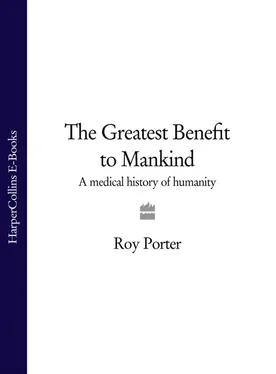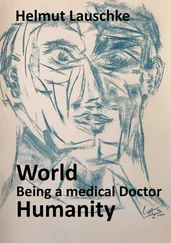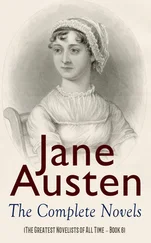In 1537 he moved to Padua, where he made his anatomical name. Dissection had previously been demonstrated there by surgeons, and had never been mandatory for physicians. The rediscovery of Galen’s On Anatomical Procedures and the wider dissemination of his On the Use of Parts meant that humanists were beating the drum for the subject, and the appointment of the young physician was one consequence. Vesalius’s Tabulae anatomicae sex (1538) [Six Anatomical Pictures] were among the first anatomical illustrations specifically designed for students. The first three sheets were drawn by Vesalius himself and represented the liver and its blood vessels, together with the male and female reproductive organs, the venous and the arterial system. He was still viewing the body through Galenic eyes: despite Berengario, he drew the rete mirabile ; the liver was still five-lobed, and the heart an ape’s.
Thereafter Vesalius grew more critical. Familiarity with human anatomy drove him to the unsettling conclusion that Galen had dissected only animals, and forced him to see that animal anatomy was no substitute for human. He now began to challenge the master on points of detail: for instance, the lower jaw comprised a single bone not two, as Galen, relying on animals, had stated. Evidently, human anatomy had to be learned from dead bodies not dead languages.
In 1539 he acquired a larger supply of cadavers of executed criminals and worked on his great masterpiece, the De humani corporis fabrica. Finishing it in 1542, he took it to Basel where the press of Joannes Oporinus published it in 1543 as one of the pearls of Renaissance printing. It presents exact descriptions of the skeleton and muscles, the nervous system, blood vessels and viscera. Though it contains no shattering discoveries, it marks a watershed in the medical understanding of bodily structures, for Vesalius interrogated Galen by reference to the human corpse. Others had criticized odds and ends of Galenic anatomy, but Vesalius was the first to do this systematically. The Fabrica gained immensely from the contribution of the artist, Jan Stephan van Calcar (1499–c. 1546), also from the Netherlands, who provided the text with technically accurate drawings displaying the dissected body in graceful lifelike poses. The work also enunciated clear methodological principles: the anatomist-lecturer must perform the dissection himself, the eye was preferable to authority, and anatomy was the skeleton key to medicine.
Book I of the Fabrica began in Galenic fashion with the bones rather than the internal organs. Various Galenic lapses were corrected: for example, the human sternum has three, not seven, segments. Book II dealt with the muscles and included the famous suite of illustrations showing ‘muscle-men’ at different stages of corporeal ‘undress’. Book III, on the vascular system, was less accurate because Vesalius still based his descriptions partly on animal material. Book IV described the nervous system, following the Galenic classification of the cranial nerves into seven pairs.
Book V dealt with the abdominal and reproductive organs, where he corrected Galen’s belief in the five-lobed human liver. He nevertheless still accepted the Galenic physiological tenet that the liver produced blood from chyle, while denying that the vena cava originated in the liver – an observation which, had Vesalius been more physiologically-minded, might have begun the erosion of the Galenic belief in two distinct vascular systems, the venous originating in the liver and the arterial stemming from the heart.
Book VI was devoted to the thorax. Examining the heart, Vesalius cast doubt on the permeability of the interventricular septum: ‘We are driven to wonder at the handiwork of the Almighty by means of which the blood sweats from the right into the left ventricle through passages which escape the human vision.’ In the second edition (1555), this implicit denial of the septum’s permeability was made direct. Here lay a milestone of Renaissance anatomy, for it encouraged anatomists like Realdo Colombo (c. 1515–59) to conceive of the pulmonary transit, later used by William Harvey as evidence of the circulation of the blood. Another crucial correction of Galen came in Book VII, on the brain, where Vesalius denied the existence of the rete mirabile in humans.
In the end, Vesalius’s importance lay in daring to think the unthinkable: that Galen might actually be wrong, and Galen worship with it:
How much has been attributed to Galen, easily leader of the professors of dissection, by those physicians and anatomists who have followed him, and often against reason! … Indeed, I myself cannot wonder enough at my own stupidity and too great trust in the writings of Galen and other anatomists.
The Fabrica thus laid the groundwork for observation-based anatomy, announcing a new principle of fact-finding and truth-testing: all anatomical statements were to be subjected to the test of human cadavers.
Later anatomists corrected Vesalius as he had corrected Galen, and independent observation thus became sovereign. Anatomists also grew impatient to establish personal priority in discovering new structures. Amerigo Vespucci had his name immortalized in a continent; for an anatomist, naming a bodily part could be crucial for making his name. *
The frontispiece of the Fabrica presents the dreams, the programme, the agenda, of the new medicine. The cadaver is the central figure. Its abdomen has been opened so that everyone can peer in; it is as if death itself had been put on display. A faceless skeleton points towards the open abdomen. Then there is Vesalius, who looks out as if extending an invitation to anatomy. Medicine would thenceforth be about looking inside bodies for the truth of disease. The violation of the body would be the revelation of its truth.
By transference, the idea of anatomizing became a potent medical metaphor during the next couple of centuries, as in Robert Burton’s Anatomy of Melancholy (1621) or John Donne’s poem ‘An Anatomy of the World’ (1611), and modern medicine adopted the anatomy lesson as its signature: medicine was represented as a probe into nature’s secrets, peeling away layer upon layer in the hunt for truth; nothing would resist its gaze. The knife also suggested other modes of mastery, not least sexual conquest, as when Donne likens the lover’s caress to a surgeon’s knife:
And such in searching wounds the surgeon is
As wee, when wee embrace, or touch, or kiss.
A new genre came into fashion: self-anatomy, introspection into one’s own soul, a kind of spiritual or psychological dissection. ‘I have cut up mine owne Anatomy,’ declared Donne, ‘dissected myselfe, and they are got to read upon me.’
Practical anatomy advanced on a broad front after the Fabrica. Accounts of the whole body continued to be published, for instance Charles Estienne’s (1504–64) De dissectione partium corporis humani (1545) [On the Dissection of the Human Body]. Realdo Colombo, an apothecary’s son who studied surgery at Padua, succeeding Vesalius there in 1544, corrected some of his errors in his De re anatomica [On Anatomy], published posthumously in 1559. He accused Vesalius of passing off descriptions of animal anatomy as human – precisely Vesalius’s charge against Galen. Colombo’s discovery of the pulmonary transit and elucidation of the heartbeat were momentous. Vivisection experiments showed that blood went from the right side of the heart through the lungs to the left side; that the pulmonary vein did not, as Galen had thought, contain air but blood; and that blood was mixed with air not in the left ventricle of the heart but in the lungs, where it took on the bright red hue of arterial blood. Describing the heartbeat, Colombo held, opposing former views, that the heart acted with greater force in systole (contraction) than in diastole (dilation); this too was crucial for Harvey.
Читать дальше












